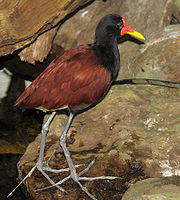
Hamiltonian spite
Encyclopedia

Social evolution
Social evolution is a subdiscipline of evolutionary biology that is concerned with social behaviors that have fitness consequences for individuals other than the actor...
, Hamiltonian spite is a term for those behaviours that occur between (among) conspecifics, and have a cost for the actor and a negative impact (harm) for the recipient(s). Why do animals and humans exhibit spiteful behaviours?
Theories on altruism and spitefulness
W. D. HamiltonW. D. Hamilton
William Donald Hamilton FRS was a British evolutionary biologist, widely recognised as one of the greatest evolutionary theorists of the 20th century....
published an influential paper on altruism
Altruism
Altruism is a concern for the welfare of others. It is a traditional virtue in many cultures, and a core aspect of various religious traditions, though the concept of 'others' toward whom concern should be directed can vary among cultures and religions. Altruism is the opposite of...
in 1964 to explain why genetic kin tend to help each other. He argued that genetically related individuals are likely to carry the copies of the same alleles, thus helping kins may ensure that the copies of the actors' alleles pass into next generations.
While this became a widely accepted and highly popular idea ever since then, however, few scientists noticed that he also published a second paper that modifies this view, or at least adds further important points to it. This paper argues that by measuring the genetic relatedness between any two (randomly chosen) individuals of a population several times, we can identify an average level of relatedness. Theoretical models predict that (1) it is adaptive for an individual to be altruistic to any other individuals that are more closely related to it than this average level, and also that (2) it is adaptive for an individual to be spiteful against any other individuals that are less closely related to it than this average level. The indirect adaptive benefits of such acts can surpass certain costs of the act (either helpful or harmful) itself. Hamilton mentioned birds and fishes exhibiting infanticide
Infanticide (zoology)
In animals, infanticide involves the killing of young offspring by a mature animal of its own species, and is studied in zoology, specifically in the field of ethology. Ovicide is the analogous destruction of eggs. Although human infanticide has been widely studied, the practice has been observed...
(more specifically: ovicide) as examples for such behaviours.
Briefly, an individual can increase the chance of its genetic alleles to be passed to the next generations either by helping those that are more closely related, or by harming those that are less closely related than relationship by chance.
Doubts about the adaptive nature of spiteful behaviour
Though altruism and spitefulness appear to be the sides of the same coin, there are good reasons why the latter one appears to be a less accepted idea among evolutionary biologists.First, unlike in the case of an altruist act, target individuals of aggression are likely to act in revenge: bites will provoke bites. Thus harming non-kins may be more costly than helping kins.
Second, presuming a panmictic population
Panmixia
Panmixia means random mating.A panmictic population is one where all individuals are potential partners. This assumes that there are no mating restrictions, neither genetic or behavioural, upon the population, and that therefore all recombination is possible...
, it is easy to see that the vast majority of pairs of individuals exhibit a roughly average level relatedness. For a given individual, the majority of others do not worth to help or harm. While it is easy to identify the few most closely related ones (see: kin recognition
Kin recognition
Kin recognition is animals' abilities to distinguish between close genetic kin and non-kin. In evolutionary biology and in psychology, such capabilities are presumed to have evolved to serve the adaptive functions of kin altruism and inbreeding avoidance...
), it is also hard to identify the few genetically most distant ones.
Most terrestrial vertebrates exhibit a certain degree of site fidelity, thus levels of kinship tend to correlate negatively with spatial distance. On one hand, this may provide some cues for them to identify the least related non-kin individuals. On the other hand, this may ensure that non-kins rarely if ever meet each other.
Infanticide
Many animal species exhibit infanticide, i.e. adults tend to kill the eggs or the offspring of conspecifics, even if they do not feed on them (in the absence of cannibalismCannibalism
Cannibalism is the act or practice of humans eating the flesh of other human beings. It is also called anthropophagy...
). This form of spitefulness is relatively free from the threat of revenge – provided that the parents and relatives of the target are either weak or far away.
Aggression by means of pathogens
An individual carrying a long-lasting infection of virulent pathogens may benefit from (1) channelling the flow of pathogens from its own body away from its kins and (2) directing them toward non-kin conspecifics. The adaptive nature of this behaviour has been supported by the analysis of theoretical models and also by the analyses of the behavioural repertoire of different animal species. Thus, tuberculosisTuberculosis
Tuberculosis, MTB, or TB is a common, and in many cases lethal, infectious disease caused by various strains of mycobacteria, usually Mycobacterium tuberculosis. Tuberculosis usually attacks the lungs but can also affect other parts of the body...
-infected European badgers and rabies
Rabies
Rabies is a viral disease that causes acute encephalitis in warm-blooded animals. It is zoonotic , most commonly by a bite from an infected animal. For a human, rabies is almost invariably fatal if post-exposure prophylaxis is not administered prior to the onset of severe symptoms...
-infected dog
Dog
The domestic dog is a domesticated form of the gray wolf, a member of the Canidae family of the order Carnivora. The term is used for both feral and pet varieties. The dog may have been the first animal to be domesticated, and has been the most widely kept working, hunting, and companion animal in...
s equally tend to emigrate from their natal ranges before starting to distribute the pathogens. Similarly, wild herds of Asian elephants tend to defecate into drinkwater holes apparently to keep rival herds away.

Wartime infanticide
Throughout human history, warWar
War is a state of organized, armed, and often prolonged conflict carried on between states, nations, or other parties typified by extreme aggression, social disruption, and usually high mortality. War should be understood as an actual, intentional and widespread armed conflict between political...
often emerges as a costly form of aggression typically targeting the non-kin enemy. Naturally, most wars appear to be motivated by potential benefits other than genetical. Nevertheless, the widespread occurrence of rape
Rape
Rape is a type of sexual assault usually involving sexual intercourse, which is initiated by one or more persons against another person without that person's consent. The act may be carried out by physical force, coercion, abuse of authority or with a person who is incapable of valid consent. The...
and infanticide
Infanticide
Infanticide or infant homicide is the killing of a human infant. Neonaticide, a killing within 24 hours of a baby's birth, is most commonly done by the mother.In many past societies, certain forms of infanticide were considered permissible...
during periods of war indicates Hamiltonian elements as well. Infanticide is a biologically spiteful action in that it costs the killer time and energy, and opens them to the threat of revenge, without any direct compensating benefits. Rape, by contrast, is not, in the strict definition of the word, biologically spiteful as it is likely to have a direct fitness increase on the rapist (by increasing his number of direct descendants in the next generation, should the victim fall pregnant).
Economy
It was recently suggested that spiteful motivations may also play a role in economic decisions.Aggression by means of pathogens
Moreover, another paper argues that the motivation for biological aggression – i.e. using pathogens as weapons – is an inherent and common aspect of the human behavioural repertoire. This argument contradicts the widespread belief that biological weapons are rare and aberrant tools of warfare and it is supported by the following observations:- the use of pathogen weapons predates the scientific understanding of infections and epidemics;
- attempts of biological aggression are easy to hide and to overlook, thus it appears to be underrepresented in written history;
- it is a frequent component of our expectations concerning the likely behaviour of an enemy;
- it is also a frequent component of threats (see e.g. white powder letters);
- several languages appear to bear linguistic references to our motivation for biological aggression in profanity.
- given that wartime epidemics tend to kill people at a rate exceeding (or at least comparable to) that of traditional weapons, all wars fought in recorded history incorporated an implicit element of aggression by biological means.

